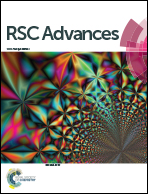H2S bubbles-assisted synthesis of hollow Cu2−xSeyS1−y/reduced graphene oxide nanocomposites with tunable compositions and localized surface plasmon resonance†
Abstract
Hollow nanostructures have been diversely applied in many fields and efforts have been made to develop their various synthesis methodologies. Herein, homogeneous hollow Cu2−xSeyS1−y/reduced graphene oxide (rGO) nanocomposites were prepared for the first time via a facile and green aqueous chemical approach using H2S gas bubble templates as soft templates at room temperature. It is found that 2D hexagonal Cu2−xSeyS1−y nanosheets assemble around the gas–liquid interface of H2S bubbles to form hollow nanospheres on the rGO sheets, wherein rGO sheets as molecular templates play a critical role in maintaining the structural integrity of single-crystal hollow Cu2−xSeyS1−y nanospheres. Increasing the S content in the precursors, i.e., increasing the amount of H2S bubbles, both the diameter and chalcogen composition (S/Se molar ratio) of hollow Cu2−xSeyS1−y/rGO nanocomposites gradually increase. The near-infrared (NIR) localized surface plasmon resonance (LSPR) in Cu2−xSeyS1−y/rGO nanocomposites, arising from the free carriers (holes) in Cu2−xSeyS1−y, gets red shifts with increasing the S content, due to the higher carrier mass and assembly degree of Cu2−xSeyS1−y.


 Please wait while we load your content...
Please wait while we load your content...